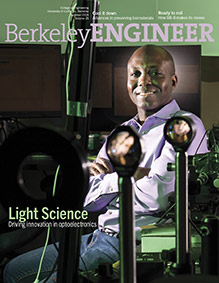
Grand designs
Metamaterials like sneaker midsoles and car bumpers are engineered to carry load or resist impact, but designing them to perform as expected can be an error-prone process. Now, Berkeley engineers have developed an innovative design method that leverages AI and additive manufacturing to create better-performing materials and simplify the manufacturing process.
“With our method, a user can input a desired mechanical behavior described by a curve, and this data is then fed into the machine learning code to generate a design — a process that takes only a few seconds. And once that design is 3D printed, it will replicate the desired mechanical behavior,” said Xiaoyu “Rayne” Zheng, associate professor of materials science and engineering. “While still in its early stages, our machine learning-based design method can produce almost any type of material behavior with nearly 90% accuracy.”
To create their approach, the researchers first made an integrated machine learning framework, which consists of an inverse prediction module and a forward validation module. Next, they developed a family of cubic symmetric, strut-based cells to train the machine learning model. The cells’ lattice structure makes it possible to achieve almost any mechanical behavior and the corresponding stress-strain curve. The researchers then 3D printed the cells and tested them to generate training datasets.
Using their new method, Zheng and his team fabricated a shoe midsole with the energy absorption and stiffness required by runners. They also demonstrated the potential for designing structures, like car bumpers, that absorb a high amount of collision energy.
According to Zheng, protective gear, soundproofing material and more complex materials like optical film coatings — as well as those featuring band gap or shape memory effects — could also be good candidates for this design and fabrication method. Eventually, this approach may lead to the creation of materials with novel properties.
“This discovery could provide a new paradigm for product and material design,” said Zheng. “One in which we are no longer limited to materials found in nature.”
Learn more:
Researchers develop new AI-based design method for metamaterials; Rapid inverse design of metamaterials based on prescribed mechanical behavior through machine learning (Nature Communications)
